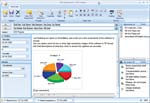
You've Got Mail
In our needed-it-yesterday world, it's easy for a simple oversight to spell disaster.
- By Marc Barrera
- Sep 01, 2009
Like clockwork, the start of each day in the office usually involves reading through at least 30 new e-mails. Among that electronic clutter, only five to six items are original, followed by numerous replies back and forth between everyone addressed. Getting up-to-date on each e-mail is a tricky proposition that often results in the accidental deletion of a reply here and there.
And what about the bozos who mistakenly hit "Reply" instead of "Reply to All"? Now, the rest of e-mail group could be missing out on some critical information. What we have here is an "unstructured process" or, as ActionBase CTO Jacob Ukelson calls it, an "unstructured ad hoc human process."
"We spend a lot of time sending and receiving e-mails from a lot of different people," Ukelson said. "These can be all scattered about, and you have to put together the context. It could be sent yesterday or the day before, and you have to go and figure out where it is. And if someone sends you an attachment, you have to make sure it's the latest version of the attachment before you work on it because maybe someone else has a different version of the attachment, and so on."
Order Amid Chaos
In safety, as well as general industry, there can be many separate, structured processes going on at one time. These are then introduced into an unstructured process when they are proliferated through e-mail. "There's lots of information flowing between people, between different parts of the organization that are flowing via e-mail and attached documents—perhaps spreadsheets, perhaps Word documents. So even if you have a structured process, you really want to have an end-to-end process," Ukelson said, adding that the problem with running processes this way is information—e-mailed information, specifically—overload.
What's Ukelson's solution to the problem? Integrate these structured processes through his Israel-based company's product, ActionBase 6.0. "What ActionBase does is to plug into your Outlook and add next to your inbox something called an ActionBox, and an ActionBox contains ActionMail instead of regular e-mail," he said. "If I go into my ActionBox, I can kick off an ActionMail just like I would kick off an e-mail, but the difference is that from that point on, that mail is tracked, monitored, and auditable."
For example, if someone sends out a mass ActionMail requesting certain actions to be carried out but realizes after the send that updates are needed to the attached file, he or she need only update said file, and that update simply replaces the previous attachment in that same ActionMail to all of the recipients; there are no new ActionMails for recipients to click through in order to have the latest file version. Also, the sender can assign deadlines to track the process of the ActionMail. If an item becomes overdue, it will turn red in a person's inbox and a notification is sent alerting the relevant people that the deadline has passed.
"So, just by opening up my Action Box, I can have a quick view of all the processes that I have currently being run and short descriptions of where they stand—whether they're in progress, whether they've been completed, whether it's overdue," Ukelson said. "If I need more detail about anyone, I doubleclick, open it up like an e-mail, and then I'll see a complete audit trail of everything that was done. And I'll also see what is still left to be done."
Multitasking
But what if you're just too busy to be writing several Action- Mails a day? ActionBase's second part is your solution: ActionDoc, which integrates with different types of documents or forms a company may use, sends out relevant ActionMails for them.
"What we do is we allow you to take any document that you may have and mark it up and say, 'Well, this paragraph here, there's an associated ActionMail that's supposed to be sent and generate this process,'" Ukelson said. "And then when you publish this—you essentially push a button that's called Publish—the ActionMails get sent off to all the people that are relevant, and that document now has generated all of those processes. If I go back into that document, no matter where it's stored, I can ask it to run a report telling me where everything stands right now."
What about external e-mails? Some won't have ActionBase running through their e-mail systems, so the company has come up with its own solution: ProcessBridge. "What the ProcessBridge does is actually translate that ActionMail into a regular e-mail.," Ukelson said. "The recipient outside of the organization will see that as a regular e-mail. Not as rich as an ActionMail, but they can then respond in kind. They can say I accept it, it's complete, or I reject it. Then they can just reply. If they reply, that goes in through the ProcessBridge and then becomes a part of the normal process flow in ActionBase."
This article originally appeared in the September 2009 issue of Occupational Health & Safety.